Scripps Institution Of Oceanography
-
- Interview: Margaret Leinen - Director, Scripps Institution of Oceanography Marine Technology, Mar 2017 #67
Scripps Institution of Oceanography – one of the premiere institutions of ocean research and higher learning on the planet – is the hinge of the Southern California blue economy. MTR recently spent some time with Margaret Leinen, Vice Chancellor, Marine Sciences, UC San Diego, Director, Scripps Institution of Oceanography, for her insights on the path forward.
I’m sure we can find Scripps’ ‘vital stats’ online, but can you give a brief overview of the Institution that you run?Scripps Institution of Oceanography at UC San Diego is a thriving center for ocean, earth and atmospheric science with more than 2,000 students, staff, researchers and volunteers. In the 113 years we’ve been in existence, our education and research mission has grown with leading experts in diverse fields across a broad spectrum of science with demonstrable value to the public. Dozens of Scripps projects throughout the United States and worldwide are problem-solving collaborations between our scientists and natural resource managers, urban planners, public health officials, the military, policymakers, philanthropists and citizen scientists.It’s thrilling to lead a truly stellar institution that features some of the greatest minds in our business. In fact, Scripps and UC San Diego were recently ranked by Nature magazine as the top earth and environmental research institution in the country, and fourth in the world. Scripps also proudly operates a research fleet with ships that have completed hundreds of missions in the past few years and our public Birch Aquarium at Scripps that welcomed nearly a half million visitors last year. I have to mention that Oceanology International has just recognized Scripps icon Walter Munk, the world-renown oceanographer and geophysicist, with a special (Catch the Wave) conference and we will be continuing that momentum with events and symposia in the months ahead as we celebrate his 100th birthday in October.In your mind, how is Scripps unique from similar institutions around the world?There are several first-rate ocean and earth science institutions making significant contributions around the world. I see Scripps Institution of Oceanography increasingly emerging as an institution that not only does the highest level of basic research on the ocean, atmosphere and earth, but also provides society with science-backed solutions to some of the world’s most urgent challenges. Science at Scripps informs urban-, state-, national- and international level policy and planning. As one example, in last year’s El Niño season Scripps performed ultra high-resolution coastal elevation surveys that are helping the U.S. Navy understand risks to coastal infrastructure and the possible relocation of facilities affected by sea-level rise. Californians see the impacts of environmental change every day. Many at Scripps are involved in research to better understand the ocean and the atmosphere with projects to improve our ability to forecast change, describe impacts to regions, and aid in developing adaptation plans.Scripps research recently helped municipalities around San Diego in understanding how to make beach nourishment efforts more cost-effective. Our scientists found that using the appropriate type of sand can help cities save millions of dollars in such efforts. This research is of great value given the impact to beaches from expected sea-level rise over the next century. We’re also ramping up a new Center for Climate Change Impacts and Adaptation to help societies adapt and prepare for the significant changes ahead for our coastal communities.What advantages do you have by being located in San Diego?Scripps research spans the globe, from pole to pole and from Earth’s interior to space. Our physical home base in San Diego, however, gives us several key advantages. For example, San Diego’s Maritime Industry Report found that our local economy supports $14 billion of direct sales, 46,000 employees, and 1,400 companies focused on technical or non-technical marine related products and services. This provides Scripps with tremendous potential to partner with industry in innovation, research and workforce development. Being part of UC San Diego and the University of California, which focus so heavily on innovation and partnerships with industry, also carries tremendous advantages. University of California researchers and entrepreneurs have spawned hundreds of new companies employing tens of thousands. These businesses have contributed more than $20 billion to the state’s economy. UC San Diego leads the UC system in startups. In fact, UC San Diego faculty, students and alumni have launched or created technology for more than 650 companies. Scripps is taking advantage of this leadership in innovation and commercialization by forging new collaborations with business partners.What is Scripps’ role in supporting, fostering the growth & benefitting from this Blue Tech cluster?The Blue Tech economy is thriving, and Scripps is doing its part to help accelerate its growth. Last year, Scripps scientists and ship operations successfully competed for more than $130 million from federal agencies to support a range of research, monitoring, infrastructure, education and training programs, which feeds into the Blue Tech economy. With a deep history of collaboration with the U.S. Navy that goes back decades, Scripps provides “environmental intelligence” that’s needed to give America an edge in terms of national security. Scripps also supports the cluster as an institution for research and education. Our faculty and staff are the experts who can provide expertise to policy makers and industry. We are training the next generation of scientific experts in earth, ocean and atmospheric studies who will go on to become leaders in academia, industry, government and non-profit work.The Scripps Nimitz Marine Facility in San Diego’s Point Loma community is the home base for our oceangoing research vessels and a major contributor to the maritime community. It’s a bustling hub of seagoing activity. Last year we welcomed home research vessel Sally Ride, the newest ship in the U.S. academic fleet. All of this activity and participation in the Blue Tech cluster provides a forum for collaboration with industry for our mutual benefit.Put in perspective how the public knowledge and perception of “the ocean” has changed over the years?Not long ago societies considered the ocean an endless resource for human cultivation. Today, of course, we see human impacts have cut across the ocean, from overfishing to pollution to increasing levels of acidity. Exploration and observation are needed to track and understand these changes.At Scripps we also see the ocean as a robust source for new marine-based medicines. Scripps is uniquely poised to translate marine-derived small molecules—from identification and characterization by our Center for Marine Biotechnology and Biomedicine with UC San Diego’s Skaggs School of Pharmacy and Pharmaceutical Sciences—into collaborations that allow for pre-clinical and clinical testing.We also have evolved to address the many unique and challenging aspects of understanding and protecting our planet. It will take more than one perspective to tackle some of our world’s most pressing challenges and as part of UC San Diego, Scripps has unique opportunities for interdisciplinary research. Pushing the boundaries of innovative research increasingly requires collaboration. With that goal in mind we recently hired several new faculty members that will launch cutting-edge research at UC San Diego that addresses key perspectives on the impact of climate change on human health, policy, resilience, adaptation and other areas.(As published in the March 2017 edition of Marine Technology Reporter) -
- Scripps Institution of Oceanography: 3D-printed Coral Are Natural Producers of Biofuels Marine Technology, May 2020 #47
Researchers at the Scripps Institution of Oceanography and the Jacobs School of Engineering at UC San Diego, alongside the University of Cambridge, UK, have 3D printed coral-like structures capable of growing dense microscopic algae populations. The work is aimed at the development of compact, efficient
-
- Scripps Institution of Oceanography: 3D-printed Coral Are Natural Producers of Biofuels Marine Technology, May 2020 #47
Researchers at the Scripps Institution of Oceanography and the Jacobs School of Engineering at UC San Diego, alongside the University of Cambridge, UK, have 3D printed coral-like structures capable of growing dense microscopic algae populations. The work is aimed at the development of compact, efficient
-
- New Ships Join the US Research Fleet Marine Technology, Oct 2015 #14
discoveries and break-through capabilities.” Sister ship R/V Sally Ride (AGOR 28) will join the fleet next year and will be assigned to Scripps Institution of Oceanography. The new ships will replace R/V Knorr (AGOR 15) and R/V Melville (AGOR 14) as part of the Navy’s portion of the ARF. Both ships have
-
- Turbulence Microstructure Measurements from a Wave Powered Profiler Marine Technology, Jul 2013 #42
The Wirewalker (WW) profiling vehicle developed by the Ocean Physics Group at Scripps Institution of Oceanography provides a platform for observing oceanographic phenomena that vary rapidly in depth and time. The smooth, “free rising” mode of operation of the WW makes it a suitable platform for the measuremen
-
- MTR100: MRV Systems LLC Marine Technology, Aug 2016 #58
surface to 6,000m depths. Some are specially designed for ease of air deployment. MRV Systems was founded in 2010, as a spin-off from the Scripps Institution of Oceanography, with a license to manufacture the SOLO II profiling float. Since then, MRV has refined the original SOLO II design to the MRV S2-A
-
- Evolution of Ocean Exploration: Mapping the Seafloor with Geodesy Marine Technology, Mar 2016 #28
bathymetry from space. “When I was a graduate student I worked on Seasat, which was a NASA altimeter satellite,” said David Sandwell, Scripps Institution of Oceanography. “When the data came out from Seasat everyone realized that the data we were looking at looked like the ocean floor – we were looking
-
- Halls of Higher Learning Marine Technology, Aug 2016 #46
just five to feature in our MTR100 was no easy feat, but our U.K.-based contributor Kira Coley, as always, gave it her best shot. Scripps Institution of Oceanography - UC San Diego Topic: Education & Outreach No. of employees: 2,238 Address: 9500 Gilman Drive, La Jolla, CA 92093 Tel: 858-534-3624 Emai
-
- Scripps' San Diego Advantage Marine Technology, Oct 2014 #44
Margaret Leinen, Director, Scripps Institution of Oceanography, UC San Diego, shares her insights with MTR regarding the internationally regarded institution and it’s Southern California roots. Can you share with MTR the history of why you are located here in the San Diego area? The story of
-
- New Scripps RV Honors Sally Ride Maritime Reporter, May 2013 #10
was the first American female astronaut and the youngest American to fly in space. The ship is owned by the U.S. Navy, will be operated by Scripps Institution of Oceanography, UC San Diego, and will have its home port at the Scripps Nimitz Marine Facility in Point Loma on San Diego Bay. “Scripps has a century-long
-
- Interview: TMA's Michael Jones on BlueTech Week Marine Technology, Oct 2018 #46
BlueTech cluster gathering in the world – to discuss Best Practices and collaboration. The Marine Debris Solutions day co-hosted with Scripps Institution of Oceanography on November 6 will focus on innovative industry solutions to four big issues: Plastics in the Ocean; Sunken Vessels and Unexploded Ordinance
-
- Sailing for Science Marine Technology, Jul 2013 #52
(NSF); Office of Naval Research (ONR); National Oceanic and Atmospheric Administration (NOAA); and University of California-San Diego’s Scripps Institution of Oceanography (SIO). NSF: Operating Costs Rise, Budgets Fall The report is an update of a similar 2007 report that summarizes the status of the
-
 )
March 2024 - Marine Technology Reporter page: 45
)
March 2024 - Marine Technology Reporter page: 45scale.” UCS hy UCS hy/UCS fO fO ce ceanog n f Ocean nography/UCS itu itu itution ofO ceanography/UCS S ipps s nstituti tion of Oceanography/UCS Scr Sc Scripps I s sI nst t st st stitu tutio i ion o o of Oceanograp phy/ y hy/UCSD D D D D D DUCSD • Unique Group signed a contract with Kongsberg Discovery
-
 )
March 2024 - Marine Technology Reporter page: 37
)
March 2024 - Marine Technology Reporter page: 37have low Figure 4 self-discharge rates, and no memory effects. They cannot be fast charged. They do have some promise of uncompromised Scripps Institution of Oceanography’s Munk-Snodgrass function if pressure compensated, though this author has nev- deep sea tide capsule with expendable ballast frame
-
 )
March 2024 - Marine Technology Reporter page: 36
)
March 2024 - Marine Technology Reporter page: 36An innovative means of pressure compensation was shown passed through the Pressure Hull via four discrete penetrators by Frank Snodgrass, Scripps Institution of Oceanography, in in the penetrator plate at the upper pole of the Pressure Hull. 1968. His wet-cell automotive batteries were open to the sea
-
 )
March 2024 - Marine Technology Reporter page: 34
)
March 2024 - Marine Technology Reporter page: 34LANDER LAB #10 BATTERY PACKS, CHARGING, AND CAPACITY TESTING Photo Credit: Hanumant Singh / Woods Hole Oceanographic Institution. By Kevin Hardy, Global Ocean Design LLC n ocean lander has many strengths including that produces the current is irreversible. Examples include ? exibility of deployment
-
 )
March 2024 - Marine Technology Reporter page: 25
)
March 2024 - Marine Technology Reporter page: 25Auerbach explained that ideally, “one ? ed layers of geothermal activity,” noted changes over an area of 8,000 km2. They would have both instruments: seismom- Skett, “and the change in salinity and dis- found up to seven km3 of displaced ma- eters to detect and locate subsurface ac- solved particles for
-
 )
March 2024 - Marine Technology Reporter page: 13
)
March 2024 - Marine Technology Reporter page: 13nyone familiar with glider hardware options integrated for a broad Glider answers that need,” said Shea autonomous underwater ve- range of missions. Quinn, Slocum Glider Product Line hicles (AUVs) is certainly “As the use of Slocum Gliders grew, Manager at TWR. A familiar with the popular- so did
-
 )
March 2024 - Marine Technology Reporter page: 6
)
March 2024 - Marine Technology Reporter page: 6(Germany) the U.S. Naval Academy, and master and doctoral degrees from that opened the hadal depths to routine exploration. He writes Scripps Institution of Oceanography. for the Journal of Diving History and the MTR. Authors & Contributors Konowe Quinn Konowe Celia Konowe is from Reston, Va., and has
-
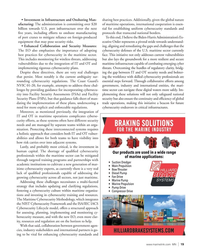 )
April 2024 - Marine News page: 19
)
April 2024 - Marine News page: 19• Investment in Infrastructure and Onshoring Man- sharing best practices. Additionally, given the global nature ufacturing: The administration is committing over $20 of maritime operations, international cooperation is essen- billion towards U.S. port infrastructure over the next tial for establishing
-
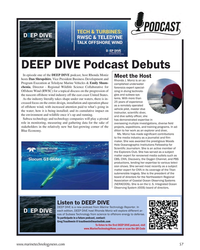 )
January 2024 - Marine Technology Reporter page: 57
)
January 2024 - Marine Technology Reporter page: 57DEEP DIVE Podcast Debuts In episode one of the DEEP DIVE podcast, host Rhonda Moniz Meet the Host hosts Dan Shropshire, Vice President Business Development and Rhonda J. Moniz is an ac- Program Execution at Teledyne Marine Vehicles & Emily Shum- complished underwater chenia, Director - Regional Wildlife
-
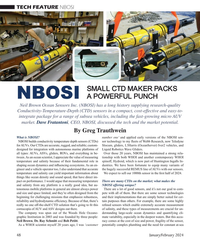 )
January 2024 - Marine Technology Reporter page: 48
)
January 2024 - Marine Technology Reporter page: 48TECH FEATURE NBOSI SMALL CTD MAKER PACKS A POWERFUL PUNCH NBOSI Neil Brown Ocean Sensors Inc. (NBOSI) has a long history supplying research-quality Conductivity-Temperature-Depth (CTD) sensors in a compact, cost-effective and easy-to- integrate package for a range of subsea vehicles, including the
-
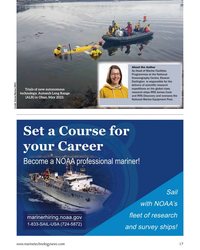 )
January 2024 - Marine Technology Reporter page: 17
)
January 2024 - Marine Technology Reporter page: 17About the Author As Head of Marine Facilities Programmes at the National Oceanography Centre, Eleanor Darlington is responsible for the delivery of scienti? c research expeditions on the global class Trials of new autonomous research ships RRS James Cook technology, Autosub Long Range and RRS
-
 )
January 2024 - Marine Technology Reporter page: 14
)
January 2024 - Marine Technology Reporter page: 14INSIGHTS SCIENCE RESEARCH MANAGEMENT © Who is Danny/AdobeStock PAVING THE WAY IN INTERNATIONAL SCIENCE RESEARCH MANAGEMENT Dr. Eleanor Darlington, Head of Marine Facilities Programs at the National Oceanography Centre (NOC), discusses how NOC is paving the way in international science research
-
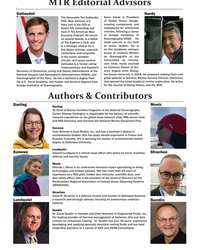 )
January 2024 - Marine Technology Reporter page: 6
)
January 2024 - Marine Technology Reporter page: 6(Germany) the U.S. Naval Academy, and master and doctoral degrees from that opened the hadal depths to routine exploration. He writes Scripps Institution of Oceanography. for the Journal of Diving History and the MTR. Authors & Contributors Darling Moniz Darling As Head of Marine Facilities Programs at
-
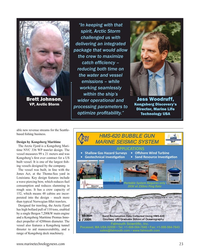 )
November 2023 - Marine Technology Reporter page: 23
)
November 2023 - Marine Technology Reporter page: 23“In keeping with that spirit, Arctic Storm challenged us with delivering an integrated package that would allow the crew to maximize catch ef? ciency – reducing both time on the water and vessel emissions – while working seamlessly within the ship’s Brett Johnson, Jess Woodruff, wider operation
-
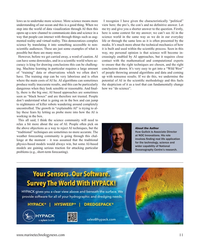 )
November 2023 - Marine Technology Reporter page: 11
)
November 2023 - Marine Technology Reporter page: 11lows us to undertake more science. More science means more I recognize I have given the characteristically “political” understanding of our ocean and this is a good thing. When we view here; the pro’s, the con’s and no de? nitive answer. Let step into the world of data visualization through AI then
-
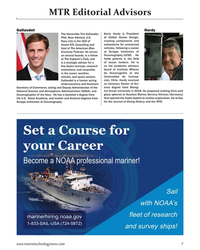 )
November 2023 - Marine Technology Reporter page: 7
)
November 2023 - Marine Technology Reporter page: 7(Germany) the U.S. Naval Academy, and master and doctoral degrees from that opened the hadal depths to routine exploration. He writes Scripps Institution of Oceanography. for the Journal of Diving History and the MTR. Set a Course for your Career Become a NOAA professional mariner! Sail with NOAA’s
-
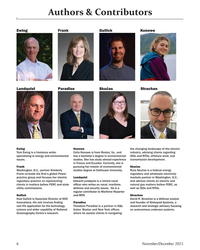 )
November 2023 - Marine Technology Reporter page: 6
)
November 2023 - Marine Technology Reporter page: 6Authors & Contributors Frank Ewing Gullick Konowe Skucas Lundquist Paradise Strachan Ewing Konowe the changing landscape of the electric Tom Ewing is a freelance writer Celia Konowe is from Reston, Va., and industry, advising clients regarding specializing in energy and environmental has a bachelor’s
-
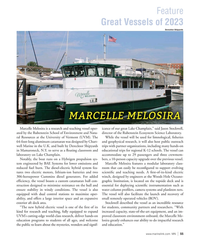 )
November 2023 - Marine News page: 55
)
November 2023 - Marine News page: 55Feature Great Vessels of 2023 Derecktor Shipyards MARCELLE MELOSIRA Marcelle Melosira is a research and teaching vessel oper- icance of our great Lake Champlain,” said Jason Stockwell, ated by the Rubenstein School of Environment and Natu- director of the Rubenstein Ecosystem Science Laboratory. ral
-
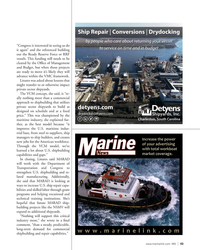 )
November 2023 - Marine News page: 43
)
November 2023 - Marine News page: 43“Congress is interested in seeing us do it again” and she referenced building out the Ready Reserve Force or RRF vessels. This funding still needs to be cleared by the Of? ce of Management and Budget, but when those projects are ready to move it’s likely they will advance within the VMC framework.
-
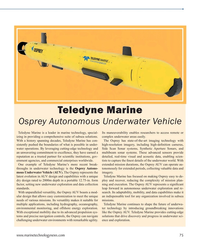 )
September 2023 - Marine Technology Reporter page: 75
)
September 2023 - Marine Technology Reporter page: 75Teledyne Marine Osprey Autonomous Underwater Vehicle Teledyne Marine is a leader in marine technology, special- Its maneuverability enables researchers to access remote or izing in providing a comprehensive suite of subsea solutions. complex underwater areas easily. With a history spanning decades,
-
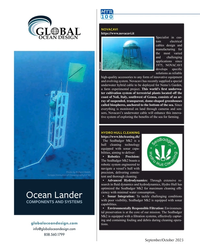 )
September 2023 - Marine Technology Reporter page: 74
)
September 2023 - Marine Technology Reporter page: 74ls ls l h, h, h, h, h, h h, precision, delivering consis- hy UCS hy/ ce nog f ceanography/U UCS itu itution f Ocea o nstitutiono fO ceanography/UCS Scripps Institution of Ocean nography/UCS Sc S Scr c ipps I s s nst st st stitu t tio io on o o o of Oceanograp p phy/ y/UCSD D D D D Dhy/U UCSD tent and
-
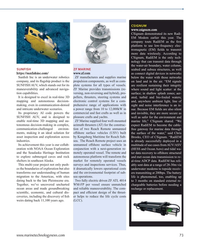 )
September 2023 - Marine Technology Reporter page: 73
)
September 2023 - Marine Technology Reporter page: 73CSIGNUM www.csignum.com CSignum demonstrated its new Radi- EM Modem earlier this year. The company touts RadiEM as the ? rst platform to use low-frequency elec- tromagnetic (EM) ? elds to transmit more data wirelessly. According to CSignum, RadiEM is the only tech- nology that can transmit data through
-
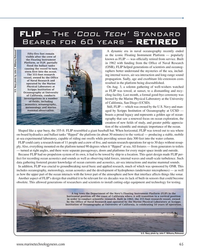 )
September 2023 - Marine Technology Reporter page: 65
)
September 2023 - Marine Technology Reporter page: 65. acoustics, oceanography, Still, FLIP — which was owned by the U.S. Navy and man- meteorology and marine mammal observation. aged by Scripps Institution of Oceanography at UCSD — boasts a proud legacy and represents a golden age of ocean- ography that saw a renewed focus on ocean exploration, the creation
-
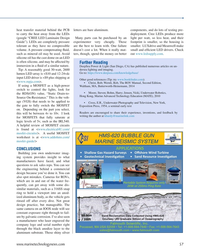 )
September 2023 - Marine Technology Reporter page: 57
)
September 2023 - Marine Technology Reporter page: 57heat transfer material behind the PCB letters are bare aluminum. components, and do lots of testing pre- to carry the heat away from the LEDs deployment. Cree LEDs produce more (google “CREE LED Luminaire Design Many parts can be purchased by an light per watt, so less heat, and their Guide”). LEDs
